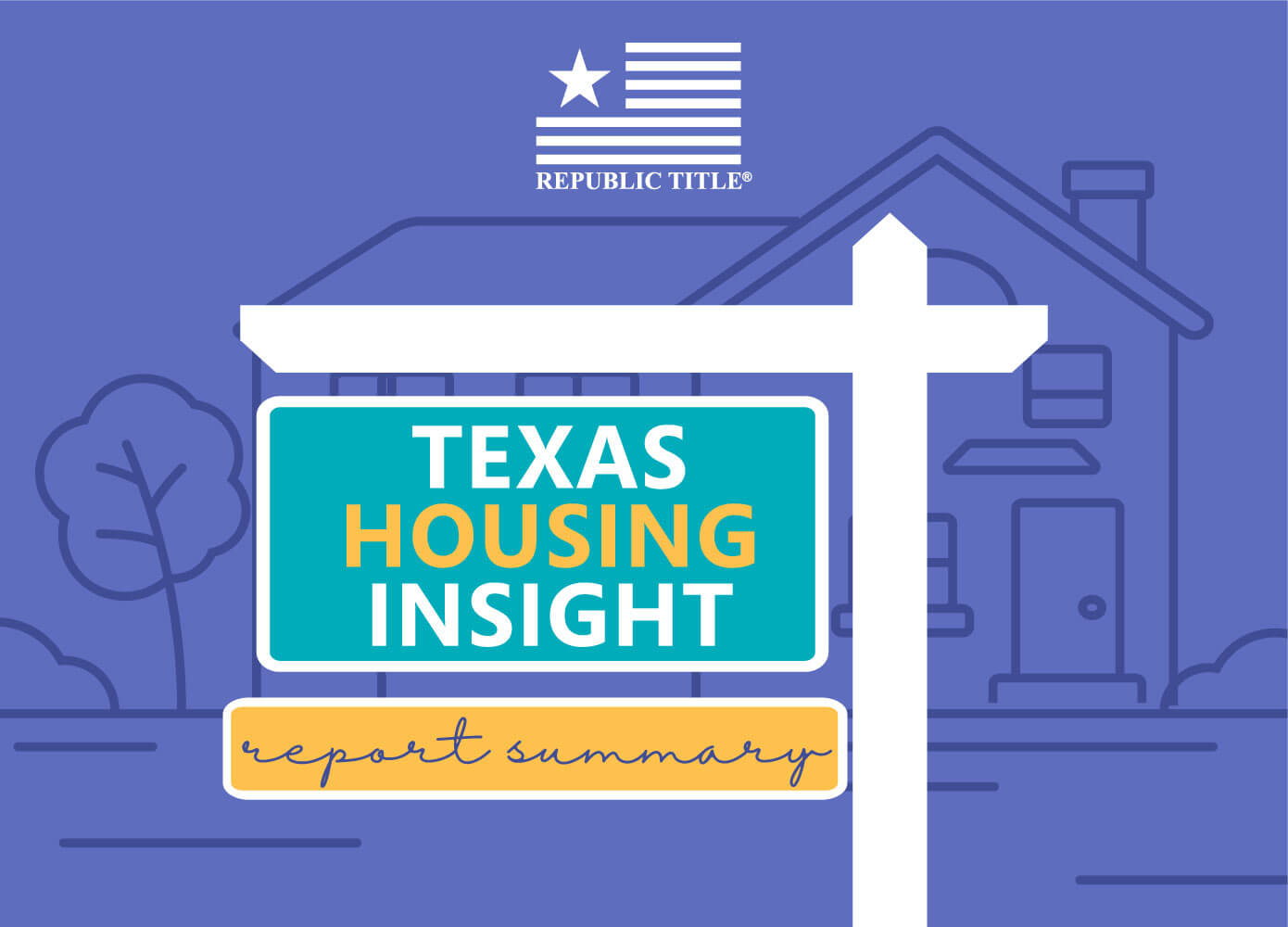
2019 Annual Summary
Texas housing sales recovered from a 2018 slowdown as homes sold through the Multiple Listing Services (MLS) increased 3.8 percent in 2019. The 30-year fixed mortgage rate fell to a three-year low, which, along with steady economic growth at both the national and state levels, bolstered housing demand. Although inventories remained constrained, especially for homes priced less than $300,000, home-price appreciation slowed for the third straight year. Housing affordability, which has supported Texas’ population and economic growth since the housing crisis, remains the greatest challenge to the Texas home market.
Single-family sales are projected to accelerate 6.4 percent in 2020, assuming mortgage rates remain relatively low and economic activity continues. Anticipated increases in supply-side activity, as indicated by improved vacant lot development, permit issuance, and housing starts, should keep price appreciation at more manageable levels than during the recovery period following the mid-decade oil bust. (For additional commentary, see the 2020 Texas Housing & Economic Outlook at www.recenter.tamu.edu.)
Supply*
The Texas Residential Construction Cycle (Coincident) Index, which measures current construction activity, rose 2.2 percent annually as industry employment increased. Momentum should continue into 2020 as indicated by the Texas Residential Construction Leading Index, which reached its highest level since before the Great Recession. Relatively low interest rates and upward-trending housing permits and starts supported the positive outlook.
In response to supply shortages, developers accelerated activity at the earliest stage of the construction cycle. According to Metrostudy, the number of new vacant developed lots (VDLs) in the Texas Urban Triangle reached its highest level in the post-recessionary period at more than 107,000, resulting in 11.2 percent annual growth. Much of the development in Houston and San Antonio were for homes intended to sell for less than $300,000. Austin developed a record 22,000 lots, although higher construction costs forced most of the development into the $200,000-$400,000 range. Activity in Dallas-Fort Worth (DFW) stepped back after eight consecutive annual increases but remained elevated compared with the metro’s five-year average.
Increased lot development in Central Texas pushed single-family housing construction permits up 2.4 percent. Austin issued a record-high 18,100 permits while San Antonio activity accelerated to 9,100 permits. Despite rising VDLs in Houston, permits flattened after exceeding 40,000 in 2018 for the first time since 2007. Meanwhile in North Texas, issuance declined 3.1 percent to 35,100 permits, driven by a moderate decrease in Dallas-Plano-Irving.
Total Texas housing starts faltered to start the year but finished strong, increasing 11.5 percent as the single-family sector gained momentum in the second half of 2019. Per Metrostudy, starts for single-family homes priced less than $200,000 rose for the first time since 2012, signaling renewed efforts to provide residences at the lower end of the price spectrum. Housing starts in that bottom price range, however, constituted only 6 percent of the 98,400 single-family homes that broke ground in the major metros. Most of the improvement was due to surges in Austin and San Antonio, corresponding to similar trends in VDLs and permits. Starts in DFW and Houston flattened, comprising two-thirds of Texas metropolitan starts, the lowest share in series history.
A total of $32.1 billion of new construction poured into Texas’ single-family market amid economic and population growth. Single-family private construction values, however, declined 5.7 percent annually after adjusting for inflation. The ratio of construction value per housing start trended downward for most of 2019, a result of homebuilders’ efforts to boost supply at the lower end of the market. At the metro level, Houston construction values normalized after an 8.2 percent increase in 2018 due to Hurricane Harvey rebuilding efforts. DFW values dropped for the second straight year as supply-side metrics stagnated. On the bright side, Central Texas activity continued to trend up, although Austin showed signs of decelerating.
Texas’ total months of inventory (MOI) fell to 3.1 months due to record-breaking sales; however, increased residential construction supported active listings as the MOI steadied at its three-year average. A total MOI of around six months is considered a balanced housing market. Inventory fell across all price cohorts, but homes priced less than $300,000 fared the worst with only 2.6 months of supply. The MOI for luxury homes (priced more than $500,000) was 5.5 months. This disparity exemplifies the shortage of affordable housing, although efforts have been made to more closely match demand and supply.
After improvement the previous year in all the major metros, only San Antonio’s MOI extended the upward trend, ticking up to 3.2 months. Fort Worth inventory flattened at 2.1 months. Austin’s metric experienced the steepest decrease with inventories the most constrained in 20 years, dropping to 1.8 months as accelerated sales chipped away at active listings. Positive momentum in early supply measures, however, bodes well for Austin inventory in 2020. The Dallas and Houston MOIs fell to 2.4 and 3.4 months, respectively, amid rapid sales, but increased supply tempered the decline.
Demand
A record 356,576 Texas homes sold through MLSs in 2019, accelerating 3.8 percent. The bottom end of the market (homes priced less than $200,000) continued to drag on activity due to a lack of supply and rising construction costs but did not hinder total sales from exceeding the national pace (1.1 percent) for the third straight year. Some of the 2019 growth can be attributed to softer sales in the previous year due to interest rate hikes, but the average 2018–19 growth was a respectable 3 percent.
At the metropolitan level, Austin led with annual growth of 5.9 percent, followed by San Antonio sales, which climbed 5.7 percent. In Houston, transactions matched 2018 improvement of 3.4 percent. North Texas sales increased 3.8 and 1.4 percent in Dallas and Fort Worth, respectively, after falling the previous year as the market adjusted to steep home-price appreciation between 2013–17.
In the new-home market, all four major metros recorded positive growth for the second consecutive year. Metrostudy data revealed Houston new-home sales increased 9.2 percent, exceeding pre-oil bust levels. Houston’s market share of new homes sold in the major metros, however, slid from 41 percent as early as 2017 to just over one-third. DFW and Austin gained market share as new-home sales increased 6.1 and 14.9 percent, respectively. Meanwhile, San Antonio sold 12,700 new homes, marking the best year since before the housing crisis.
Homeownership across the country flattened at 64.5 percent and decreased slightly in Texas to 62.4 percent. Although the recent rise in home purchases by millennials relieved some of the downward pressure associated with an aging population, many potential homeowners struggle with saving enough money for a down payment. On the positive side, the decrease in homeownership may be partially due to an increasing number of young adults forming their own households, in which case the first step is typically renting versus buying a home, as they become financially independent. Moreover, net domestic migration as a portion of Texas’ overall population growth in 2019 rose to its highest level since 2006 at 34.2 percent. Movers from other states likely added to the household count but may not have been able to purchase a home right away. On the metro level, San Antonio maintained the highest homeownership rate at 62.5 percent despite declining relative to 2018. The metric in DFW also decreased, falling to 60.7 percent. Austin and Houston, on the other hand, registered increases in homeownership, pushing the rate up to 59.0 and 61.3 percent, respectively.
Amid solid economic growth, Texas’ average days on market (DOM) balanced at 59 days, corroborating robust housing demand. San Antonio’s DOM matched that of the statewide measure versus 57 days in 2018 as inventory increased. The metric moved similarly in Houston as the average home sold after 57 days compared with 56 days the previous year. Demand softened in DFW but remained strong relative to the rest of the state, averaging 53 and 43 days in Dallas and Fort Worth, respectively. After ticking up for four straight years in Austin, the metro’s DOM stabilized at 55 days.
Interest rates fell through the first three quarters of 2019 and hovered at levels unseen since the mid-decade oil bust as the national economy continued to grow in its longest expansion on record. Uncertainty regarding trade disputes and the slowing global economy pulled long-term rates below those for short-term instruments (inverting the yield curve) to start the second half of the year but has since reverted to normal conditions. The ten-year U.S. Treasury bond yield averaged 2.1 percent while the Federal Home Loan Mortgage Corporation’s 30-year fixed-rate shed 60 basis points, falling to 3.9 percent. Texans capitalized on lower rates, pushing mortgage applications for home purchases up 26.7 percent compared with 2018. Refinance mortgage applications, which are more sensitive to interest rate fluctuations, nearly tripled during the same time period.
Prices
Despite low inventory and increased sales, home-price appreciation decelerated to its slowest pace since 2011. The Texas median home price jumped 3.2 percent annually relative to growth of 4.3 percent in 2018. Although the growth rate moderated, the median price reached an all-time high of $240,000, a $7,500 increase. Some of the upward pressure may be due to a distributional shift in sales activity away from homes priced below $100,000.
Median price appreciation in Texas’ major metros moderated. The median home price in Austin ($315,000) and San Antonio ($230,000), rose 3.3 and 3.6 percent, respectively. Fort Worth’s median home price climbed 5 percent but just surpassed the statewide average at $243,600, while the Dallas metric increased 2.5 percent to $292,000. Houston was the exception where the median price growth rate accelerated from 3.1 to 4.3 percent in 2019, resulting in a $10,000 hike to $245,000.
The Texas Repeat Sales Home Price Index, a better measure of changes in single-family home values, provides insight into how Texas home prices evolve. The index rose 3.8 percent year over year (YOY) in 4Q2019, matching the growth rate in 4Q2018. In Austin, the index was more in line with economic theory as it pertains to dwindling supply and rising demand than the metro’s median price, accelerating 5.4 percent relative to 2.9 percent the previous year. San Antonio’s index exhibited upward pressure, rising 4.2 percent as sales activity picked up. The Dallas and Fort Worth indexes continued to reduce pace to 2.2 and 4.0 percent growth, respectively, after increasing about 8 percent mid-decade. Houston’s metric experienced steady growth at 2.6 percent.
Slower home-price appreciation and lower interest rates boosted housing affordability. The National Association of Home Builders/Wells Fargo Housing Opportunity Index measures the share of homes sold that would have been affordable to a family earning the local median income, based on standard mortgage underwriting criteria. In 3Q2019, the national estimate was 64.3 percent, up nearly 7 percentage points from one year prior. In Texas, the major metros reported increased affordability. Austin was the most affordable with an index value of 66.1, an improvement of 11.3 percentage points from 3Q2018. The San Antonio and Houston indices were close behind at 64.9 and 64.6 percent, respectively. Although affordability rose in Dallas and Fort Worth, the proportion of homes that families earning the local median income could afford fell below the nationwide average at 57.8 and 62.7 percent, respectively. Texas enjoyed greater affordability than the rest of the country in the years prior to and immediately following the Great Recession, but, it has recently seen a decline in affordability. Continued improvement is important to Texas’ demographic advantages that have supported the state’s economic prosperity over the past decade.
Source – James P. Gaines, Luis B. Torres, Wesley Miller, and Paige Silva (February 5, 2020) https://www.recenter.tamu.edu/articles/technical-report/Texas-Housing-In…









